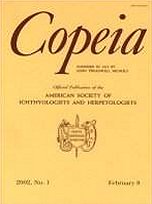We examined oral grasping behavior, a unique and relatively unknown method of maintaining station against flow, in nine species of North American cyprinids to determine whether oral grasping was used by a range of cyprinid species and to further investigate the relationship between oral grasping and water velocity. Fish were subjected to a stepwise increasing velocity test in a 100-liter laboratory swim tunnel that had wire mesh (0.6-mm diameter) attached to a flow filter serving as the grasping substrate. Frequency and duration of oral grasping events were noted for a particular fish during each velocity increment. We observed 608 grasping events, and oral grasping behavior was exhibited by all nine species examined. Mean number of grasping events was high (28.4/trial) for Cyprinella venusta, intermediate (approximately 18/trial) for Cyprinella camura, and Notropis longirostris, and low (< 5/trial) for Notropis texanus, Notropis maculatus, and Notropis wickliffi. Although critical swimming speed varied among species, the water velocity at which oral grasping behavior initially appeared (threshold grasping velocity), expressed as a percentage of critical swimming speed, was approximately 70–80% for most species tested. Oral grasping may be triggered by the onset of muscular fatigue, and is an attempt by minnows to maintain position in water velocities exceeding aerobic swimming ability. We speculate that minnows in lotic environments use oral grasping when high, energetically demanding water velocities are unavoidable, such as during a flood.
How to translate text using browser tools
1 December 2003
Oral Grasping: A Distinctive Behavior of Cyprinids for Maintaining Station in Flowing Water
S. Reid Adams,
Ginny L. Adams,
Jan Jeffrey Hoover
ACCESS THE FULL ARTICLE





